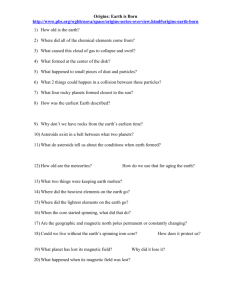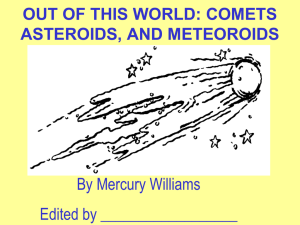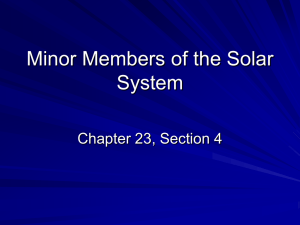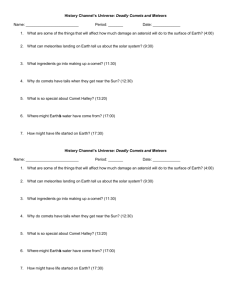Primordial Matter in the Solar System
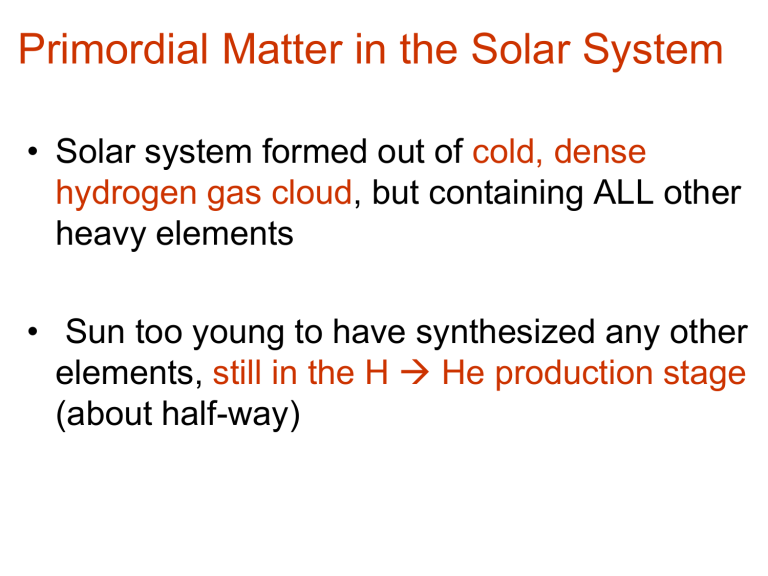
Primordial Matter in the Solar System
• Solar system formed out of cold, dense hydrogen gas cloud , but containing ALL other heavy elements
• Sun too young to have synthesized any other elements, still in the H He production stage
(about half-way)
Planetesimals or Minor Planets
• In addition to the Sun and 8 planets and we have
-Asteroid Belt , rocky/metallic bodies (also called minor planets or planetesimals ) up to 1000 Kms in diameter,
-- Planet never formed, or broken up by Jupiter ’ s tidal effect
-- Pluto and Kuiper Belt Objects (KBOs)
‘ Debris ’ of the Solar System
• The ice/rock dichotomy is most starkly evident in comets and asteroids
• Meteoroids in space; meteors or meteorites when they enter the Earth ’ s atmosphere
Comets/Meteors are mainly ice(snow) balls, and
Asteroid/Meteorites are rocky/metallic objects
• Comets would have been a source of water on the
Earth
• Comets originate in either (i) the Oort Cloud at the edge of the solar system, or (ii) the Kuiper Belt beyond the orbit of Pluto
Planetesimals etc.
• Minor planets or asteroids, comets, and other objects orbiting the Sun obey
Kepler ’ s laws
• Kuiper Belt Objects (KBO ’ s) are planetesimals beyond Pluto ’ s orbit
• Recently discovered (at least) two
“ planets ” comparable to Pluto, named
Xena and Sedna
Asteroids
• Over 5000 found between 2.8-3.2 AU
• Keplerian orbits, e.g. P 2 = a 3
• Gaps, such as the Kirkwood Gap, due to orbital resonance with Jupiter and other asteroids (like the Cassini Division in Saturn ’ s rings)
• Jupiter maintains the asteroid belt, although may have prevented planet formation
• Families of asteroids: Floras, Trojans, and the AAA objects -- Amors Appolos, Atems – that could come close to Earth (Dinosaurs !)
Asteroids (Contd.)
• Small albedo ~ 0.1-0.2
• Masses: Largest about 1/20,000 of the mass of the Earth; all asteroids combined would still be only about 1/1000 of M(E)
• Composition of Asteroids Meteorites ; metallic and silicates mixed with organic carbon compounds
Meteorites
• “ Stones from Heaven ” Excalibur, Ka ’ aba
(black) stone, etc.; survive atmospheric friction and land on Earth)
• Metallic ones with pure iron; surprising ?
• Extraterrestrial origin since Iron never occurs in pure form on the Earth but as iron ore compounds
• Stones (silicates), Irons (iron and nickel),
Stony-irons (silicates and metals)
• Largest meteorite (Namibia): 7m 3 , 60 tons
• Ages from radioactivity 4.6 Gyrs
Typical asteroids
Meteorite damage!
Barringer Crater (Flagstaff, AZ)
Stony Carbonaceous chondrites
(Allende Meteorite)
Stony Iron Meteorite
Glassy nodules on exterior. Why?
Iron Meteorite
(Interlocking crystal pattern)
Comets
Comets: Head and Tail
Where is the Sun (which direction) ?
Orbits of comets
Altering orbits of comets
Long-period comet
Short-period comet
The Tale of Two Tails!
Gaseous and Ionic Tails
ice/dust tail (white)
Ion tail (blue)
Ice/dust tail: Evaporating mattter as the comet approaches the Sun
Ion tail: charged particles
Electrons, protons, ions pushed directly away by charged particles in the
Solar Wind
Structure of comets
The vaporizing nucleus
Cometary Orbit Around the Sun
Comets
• Ancient remnants of the Solar nebula
• Long period comets from the Oort Cloud; short period ones from the Kuiper Belt
• Total number about 10 trillion !
• Structure Nucleus, Coma, H-cloud, Tail
• Tail(s): Gaseous and Ionic
• Nucleus ~ 5-10 Kms diameter, less than ten billionth of the mass of the Earth
• Total mass in comets about 1000 times
Earth ’ s mass (all the planets combined)
Comets (Contd.)
• Formed out of the building blocks of the
Solar System: Ices (H2O, CO2), like the outer planets
• Large eccentricity
• Evaporate while approaching the Sun; the tail gets longer
• Sometimes break up , e.g. Comet
Shoemaker-Levy in 1993
• Meteor Showers , e.g. Leonid shower in 2001
Meteors
• “ Shooting Stars ”
• Icy/Dusty pieces like cometary material, or small pieces from comets
• Burn up completely in the atmosphere
• Meteor showers appear to originate at a common point optical illusion like parallel rail tracks meeting in the distance


